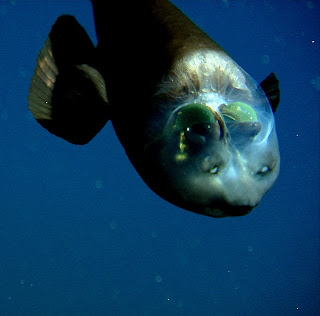Macropinna Microstoma
Macropinna Microstoma
Macropinna microstoma is the only species of fish in the genus Macropinna, belonging to Opisthoproctidae, the barreleye family. It is recognized for a highly unusual transparent, fluid-filled dome on its head, through which the lenses of its eyes can be seen. The eyes have a barrel shape and can be rotated to point either forward or straight up, looking through the fish's transparent dome. M. microstoma has a tiny mouth and most of its body is covered with large scales. The fish normally hangs nearly motionless in the water, at a depth of about 600 metres (2,000 ft) to 800 metres (2,600 ft), using its large fins for stability and with its eyes directed upward. In the low light conditions it is assumed the fish detects prey by its silhouette. MBARI researchers Bruce Robison and Kim Reisenbichler observed that when prey such as small fish and jellyfish are spotted, the eyes rotate like binoculars, facing forward as it turns its body from a horizontal to a vertical position to feed. Robison speculates that M. microstoma steals food from siphonophores.Several fish species with tubular eyes have additional structural adaptations that help to compensate for their restricted visual fields. Some scopelarchids have a pad of fibrous light-guides that direct light from the side and below, to the accessory retinal tissue inside the tube . Parallel, upward directed, tubular eyes allow a fish to see its prey silhouetted against the lighted waters above (at least during the day) and to accurately judge its distance. In general, the position of tubular eyes has been assumed to be fixed.



Comments
Post a Comment